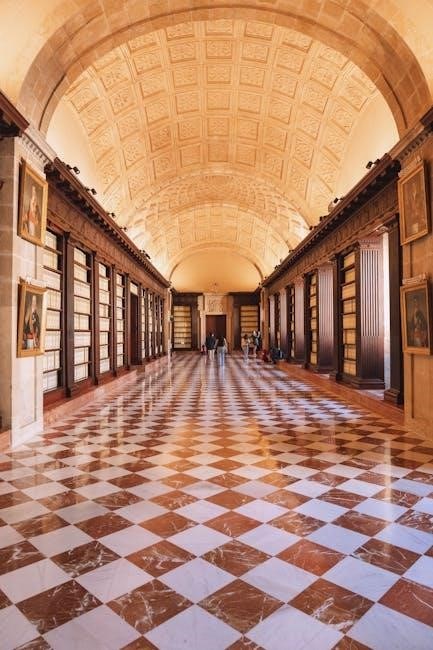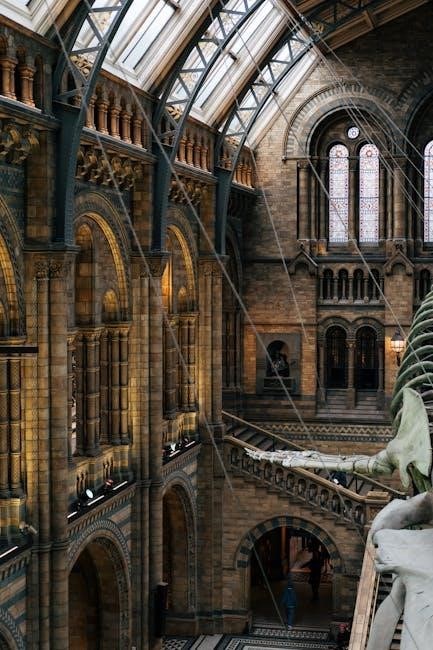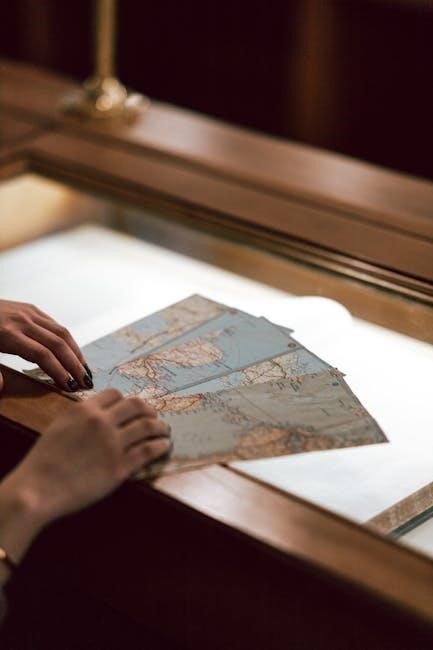World history explores the development of human societies, tracing themes like migration, culture, and technology. It connects past events to understand our globalized present and future challenges.
Key Themes in World History
Key themes in world history include cultural exchange, migration, technological advancement, and the rise and fall of empires. These themes highlight how societies have interacted, adapted, and evolved over time. Religion, trade, and warfare have shaped global connections, while environmental factors and scientific discoveries have driven societal progress. The interplay of continuity and change underscores how historical events influence contemporary issues. Understanding these themes provides a framework for analyzing patterns and transformations across different regions and periods, helping to build a cohesive narrative of human development and global interdependence.
Importance of Studying World History
Studying world history fosters critical thinking and global awareness by examining past societies and events. It helps understand cultural diversity, political systems, and economic developments that shaped the modern world. By analyzing historical patterns, individuals can better grasp the complexities of global challenges and opportunities. World history also promotes empathy and tolerance by revealing shared human experiences across time and space. It equips learners with a broad perspective, enabling them to navigate an increasingly interconnected world and make informed decisions about the future.

Major Periods in World History
World history is divided into key periods: Ancient Civilizations, Medieval, Early Modern, and Modern. Each era reflects societal evolution, cultural advancements, and transformative global events shaping humanity’s journey.
Ancient Civilizations (3000 BCE ⏤ 500 CE)
Ancient civilizations laid the foundation for modern society, with Mesopotamia, Egypt, China, and others developing writing, governance, and architecture. These societies harnessed agriculture, established trade networks, and created cultural legacies. Mesopotamia’s cuneiform and Egypt’s hieroglyphs revolutionized communication, while China’s Great Wall and pyramids in Egypt showcased engineering prowess. Philosophical and religious movements, such as Buddhism and Christianity, emerged during this period. The rise and fall of empires like Rome and Qin shaped global dynamics, leaving lasting impacts on law, art, and technology. This era’s innovations continue to influence contemporary cultures and civilizations worldwide.
Medieval Period (500 ⏤ 1500 CE)
The medieval period was marked by feudalism, religious influence, and cultural transformation. Following the fall of the Roman Empire, Europe saw the rise of Christianity and the power of the Catholic Church. Feudal systems dominated societies, with lords and vassals shaping political and economic structures. The Crusades and the Black Death were pivotal events, impacting demographics and global relations. Meanwhile, Islamic Golden Age advancements in science and philosophy flourished. Trade networks expanded, connecting Europe, Asia, and Africa. This era laid the groundwork for the Renaissance and the transition to the early modern world, blending tradition with emerging innovations.
Early Modern Period (1500 ⎯ 1800 CE)
The Early Modern Period was a transformative era marked by cultural, religious, and political revolutions. The Renaissance revitalized art and science, while the Protestant Reformation challenged Catholic dominance. Exploration and colonization expanded global connections, shaping economies and societies. The Enlightenment emphasized reason and individual rights, influencing modern political thought. This period also saw the rise of nation-states and the development of global trade networks, laying the foundation for industrialization and the complexities of the modern world.
Modern and Contemporary Period (1800 CE ⎯ Present)
The Modern and Contemporary Period saw transformative changes, beginning with the Industrial Revolution, which reshaped economies and societies. Nationalism and ideologies like socialism and fascism emerged, influencing global conflicts. World Wars I and II caused unprecedented destruction, leading to the Cold War’s geopolitical tensions. Decolonization reshaped global politics, while technological advancements and globalization interconnected the world. This era also witnessed civil rights movements and environmental awareness, shaping modern identity and challenges. The internet and digital revolution marked the 21st century, creating new opportunities and complexities in an increasingly interconnected world.
Historical Research and Methods

Historical research involves analyzing evidence from the past to understand events and cultures. Methods include evaluating primary sources, archaeological findings, and interpreting data to reconstruct history accurately.
Primary and Secondary Sources
Primary sources are original materials from the time period being studied, such as documents, artifacts, and eyewitness accounts. Secondary sources are interpretations or analyses of primary sources, like books or articles. Primary sources provide direct evidence, while secondary sources offer context and perspective. Historians use both to reconstruct the past, ensuring a balanced and accurate understanding. Digital archives and academic databases now make these sources more accessible. Critical evaluation of sources is essential to verify credibility and relevance, helping historians build a comprehensive narrative of historical events and cultural developments.
Archaeological Contributions to History
Archaeology provides invaluable insights into history by uncovering physical evidence from past societies. Through excavation, artifacts such as tools, texts, and structures reveal cultural, social, and technological developments. These findings fill gaps where written records are scarce or absent, offering a tangible connection to ancient civilizations. Archaeological discoveries, like inscriptions or pottery, help reconstruct timelines and lifestyles. Advanced techniques, such as radiocarbon dating, enhance accuracy. By analyzing these materials, historians gain a more comprehensive understanding of human evolution, trade networks, and societal transformations. Archaeology bridges the past with the present, enriching our knowledge of global history.
Interpreting Historical Documents
Interpreting historical documents involves analyzing texts, such as letters, treaties, and official records, to understand their context, purpose, and significance. Historians consider the author’s perspective, the time period, and the cultural backdrop to avoid misinterpretation. Primary sources like diaries or speeches provide firsthand insights, while secondary sources offer later analyses. Cross-referencing documents ensures accuracy and reveals biases. Understanding the language, tone, and intended audience is crucial. Historical documents are essential for reconstructing past events, identifying patterns, and drawing meaningful conclusions about societies and their evolution over time.

Major Civilizations and Empires
Major civilizations like Mesopotamia, Egypt, China, Greece, and Rome laid the foundation for modern societies, contributing advancements in law, architecture, philosophy, and governance that shaped global history.
Ancient Mesopotamia, Egypt, and China
Ancient Mesopotamia, often called the “cradle of civilization,” developed writing (cuneiform), law codes, and governance systems; Egypt’s pyramids and hieroglyphs showcased architectural brilliance and cultural depth. China’s early dynasties introduced innovations like the compass and Confucian philosophy, shaping East Asian thought. These civilizations laid the groundwork for advances in technology, governance, and culture, influencing later societies globally. Their legacies remain visible in modern law, architecture, and philosophy, highlighting their enduring impact on human history.
Greek and Roman Civilizations
Ancient Greece laid the foundation for Western philosophy, democracy, and the arts. Philosophers like Socrates, Plato, and Aristotle shaped critical thinking, while Greek city-states like Athens pioneered democratic governance. The Romans, in turn, developed a sophisticated legal system and infrastructure, leaving legacies in law, architecture, and governance. Both civilizations profoundly influenced art, literature, and political systems, shaping the modern world. Their contributions remain central to understanding the evolution of Western civilization and its global impact.
Columbian Exchange and Global Empires
The Columbian Exchange, following Columbus’s voyages, reshaped global trade and culture by transferring plants, animals, and ideas between the Americas and Europe. This exchange revolutionized agriculture, demographics, and economies. Concurrently, European powers established vast empires, with Spain, Portugal, Britain, France, and the Netherlands dominating regions worldwide. These empires facilitated the spread of Christianity, languages, and technologies while often displacing indigenous populations. The rise of global empires also spurred conflicts over resources and territory, shaping modern nation-states and economic systems like plantation economies and global trade networks that persisted into the 18th century.
Religion and Culture in History
Religion and culture have deeply shaped societies, influencing laws, traditions, and identities. They reflect human values and beliefs, shaping art, literature, and global diversity throughout history.
Role of Religion in Shaping Societies
Religion has profoundly shaped societies by influencing laws, social norms, and cultural practices. It has served as a moral framework, guiding individuals on ethics and behavior. Major religions like Christianity, Islam, and Buddhism have shaped political systems, art, and education. Religious beliefs often unify communities, fostering identity and shared values. Historical records show how religious texts and symbols have inspired movements for justice and equality. However, religion has also been a source of conflict, highlighting its dual role in human history. Understanding its impact is crucial for grasping the complexities of societal development and cultural evolution.
Cultural Exchange and Its Impact
Cultural exchange has been a driving force in world history, fostering innovation and understanding. The Silk Road and Columbian Exchange exemplify how goods, ideas, and religions were shared across vast regions. This exchange spurred technological advancements and linguistic diversity. While it enriched societies by blending traditions, it also posed challenges like cultural homogenization and conflict. Understanding these dynamics is essential for appreciating the interconnected nature of global societies and the complexities of cultural evolution.

Global Conflicts and Their Legacies
Global conflicts, such as World Wars and the Cold War, have shaped modern political landscapes, economies, and societies. Their legacies include technological advancements and social change.
World Wars and Their Consequences
The World Wars reshaped global politics, economies, and societies. World War I led to the rise of new nations and the collapse of empires, while World War II resulted in the emergence of the United States and the Soviet Union as superpowers. Both wars caused unprecedented human suffering and economic devastation. The aftermath of these conflicts saw the establishment of international organizations like the United Nations to promote peace and cooperation. Additionally, the wars spurred technological advancements and social changes, including the civil rights movement and the decolonization of Africa and Asia.
Cold War and Its Impact on Global Politics
The Cold War, spanning 1947–1991, was a ideological and geopolitical rivalry between the U.S. and the Soviet Union. It shaped global politics through proxy wars, arms races, and ideological battles. Key events included the Korean and Vietnam Wars, the Cuban Missile Crisis, and the Space Race. The conflict fueled the formation of alliances like NATO and the Warsaw Pact. Its end marked the collapse of Soviet communism, leading to a unipolar world dominated by the U.S. The Cold War’s legacy includes ongoing tensions, nuclear proliferation, and a reshaped global order.
